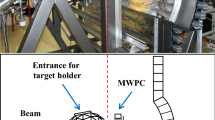Summary
The polarization in p-Be and p-p scattering has been measured by counter techniques at a proton kinetic energy of 1.74 GeV. The maximum polarization in p-Be scattering was found to beP max==0.19±0.04 and occurs at an angleθ max⩾3.5°. Inelastic scatters were rejected when the inelastic momentum loss was more than about 1% in the first scatter (magnetic analysis) or more than about 5% in the second scatter (Čerenkov threshold counter). The maximum polarization in p-p scattering isP max=0.30±0.09 and occurs at an angle 35°<θ max<<55° (c.m.). The angular dependence of the polarization is consistent with a distribution proportional to sin 2θ within large statistical errors. Optical model calculations applied to the data on p-Be scattering yield an almost all imaginary central potential of about 43 MeV and a spin-orbit potential of between 0.9 MeV and 2.0 MeV which is also almost all imaginary, in contrast with the predominantly real spin-orbit potential needed to explain the large polarization in the region of several hundred MeV.
Riassunto
Abbiamo misurato con la tecnica dei contatori la polarizzazione nello scattering p-Be e p-p con protoni di 1.74 GeV di energia cinetica. Abbiamo trovato che la massima polarizzazione nello scattering p-Be èP max=0.19±0.04 e si ha per un angoloθ max⩾3.5°. Abbiamo scartato gli scattering anelastici quando la perdita anelastica dell’impulso era più dell’1% circa nel primo scattering (analisi magnetica) o più del 5% circa nel secondo scattering (contatore di soglia di Čerenkov). La polarizzazione massima nello scattering p-p èP max=0.30±0.09 e si ha per un angolo di 35°<θ max<55° (c. m.). La dipendenza angolare della polarizzazione è coerente con una distribuzione proporzionale a sin 2θ entro ampi errori statistici. Calcoli del modello ottico applicati ai dati dello scattering p-Be danno un potenziale centrale, quasi tutto immaginario, di 43 MeV circa ed un potenziale spin-orbita compreso fra 0.9 MeV e 2.0 MeV, che è anche quasi tutto immaginario, in contrasto con il potenziale spin-orbita predominantemente reale necessario per spiegare la forte polarizzazione nella zona delle parecchie centinaia di MeV.
Similar content being viewed by others
References
P. Prugne, M. Marquet andM. Bougon Onde Electrique,39, 612 (1959).
W. M. Preston, R. Wilson andJ. C. Street:Phys. Rev.,118, 579 (1960).
H. A. Bethe:Ann. Phys.,3, 190 (1958).
E. Fermi:Suppl. Nuovo Cimento,2, 84 (1955).
W. B. Riesenfeld andK. M. Watson:Phys. Rev.,102, 1157 (1956).
F. F. Chen, C. P. Leavitt andA. M. Shapiro:Phys. Rev.,99, 857 (1955).
M. G. Mescheriakov, S. B. Nurushev andG. D. Stoletov:Soviet Physics JETP,4, 337 (1957).
J. M. Dickson, B. Rose andD. C. Salter:Proc. Phys. Soc.,68, 381 (1955).
P. Hilmann, A. Johansson andH. Tyren:Nucl. Phys.,4, 648 (1957).
W. G. Chesnut, E. M. Hafner andA. Roberts:Phys. Rev.,104, 449 (1956).
O. Chamberlain, E. Segrè, R. D. Tripp, C. Wiegand andT. Ypsilantis:Phys. Rev.,96, 807 (1954) and102, 1659 (1956).
H. G. De Carvalho, J. Marshall andL. Marshall:Phys. Rev.,96, 1081 (1954).
E. Heiberg, U. Kruse, J. Marshall, L. Marshall andF. Solmitz:Phys. Rev.,97, 250 (1955).
N. E. Booth, F. L. Hereford, M. Huq, G. W. Hutchinson, M. E. Law, A. M. Segar andD. H. White:Proc. of Int. Conf. on High Energy Physics at CERN (1958), p. 307.
C. J. Batty, W. O. Lock andP. V. March:Proc. Phys. Soc.,73, 100 (1959).
C. J. Batty andS. J. Goldsack:Proc. Phys. Soc.,72, 1130 (1958).
A. E. Taylor:Proc. of the VI Ann. Intern. Rochester Conference on High Energy Physics, p. 13.
E. Baskir, E. M. Hafner, A. Roberts andJ. H. Tinlot:Phys. Rev.,106, 564 (1957).
J. M. Dickson andD. C. Salter:Nature,173, 946 (1954).
D. Fisher andJ. Baldwin:Phys. Rev.,100, 1445 (1955).
O. Chamberlain, E. Segrè, R. D. Tripp, C. Wiegand andT. Ypsilantis:Phys. Rev.,105, 288 (1957).
J. A. Kane, R. A. Stallwood, R. B. Sutton, T. H. Fields andJ. G. Fox:Phys. Rev.,95, 1694 (1954).
M. G. Mescheriakov, S. B. Nurushev andG. D. Stoletov:Soviet Physics JETP,6, 28 (1958).
R. J. Homer, G. W. Hutchinson, W. K. McFarlane, A. W. O’Dell, R. Rubinstein andE. J. Sacharidis:Nuovo Cimento,16, 1132 (1960).
H. Feshbach:Ann. Rev. Nucl. Sci.,8, 49 (1958).
Barge et al.: private communication.
Author information
Authors and Affiliations
Rights and permissions
About this article
Cite this article
Bareyre, P., Detoeuf, J.F., Smith, L.W. et al. Polarization in proton-beryllium and proton-proton scattering at 1.7 GeV. Nuovo Cim 20, 1049–1066 (1961). https://doi.org/10.1007/BF02732517
Received:
Published:
Issue Date:
DOI: https://doi.org/10.1007/BF02732517




